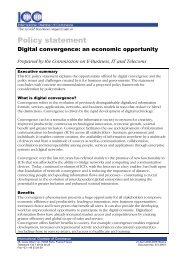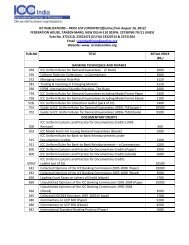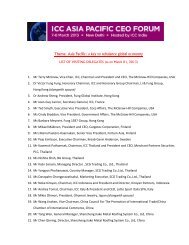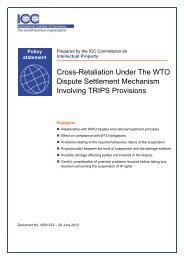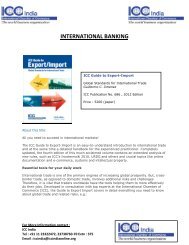2013 - ICC India
2013 - ICC India
2013 - ICC India
- No tags were found...
You also want an ePaper? Increase the reach of your titles
YUMPU automatically turns print PDFs into web optimized ePapers that Google loves.
<strong>ICC</strong> BANKING COMMISSION | <strong>2013</strong> GLOBAL RISKS TRADE FINANCE | APPENDIX B 57In estimating the LGD, banks need to:Discount the recoveries – the requirement to use economic loss is intendedto reflect the time value of money (i.e. the fact that banks may preferto recover 90% of the exposure today rather than 100% of the exposurein 10 years). In reality, for short-term trade finance products, as shownabove, the time to recover appears to be relatively short, so discountingis unlikely to change the conclusions significantly. For medium-termtrade finance exposures, this discounting effect would have more of animpact on economic loss, were it not for the fact that the ECA guaranteestypically cover interest due on the loan (in proportion to the coveragelevel). Thus the discounting/time value of money effect is typically coveredby these payments.Determine an appropriate discount rate – while there appears to be adegree of consensus amongst banks about certain aspects of the Baselframework, such as how to build a PD model, banks have adopted a varietyof different discount rates for LGD purposes. For example, some use thebank’s weighted average cost of capital, while others use a CAPM-styleapproach to determine an appropriate discount rate.Include a measure of indirect costs within the estimate – given that firmswith higher default rates will probably require more people in the workoutdepartment etc., the intention is that the costs of these and other areasrelated to the management of defaulted assets should be covered withinthe LGD estimate. In general these costs are not included within the writeoffsfor accounting purposes, so they need to be added to the write-offamounts or deducted from the recovery amount. As noted above, we haveused a value of 2%, although indications from the banks supplying data tothe Trade Register are that they typically experience lower recovery coststhan this.Derive appropriate downturn LGD estimates – banks have adopted a fewdifferent approaches for estimating the impact of downturns on recoveryrates and hence on LGDs:■■■■■■Applying stresses to key drivers – where firms haven’t had data from adownturn period or feel that what they have is insufficient, some havechosen to apply expert adjustments to the data they do have to derive afigure.Experience in a downturn period – a starting point for many firms hasbeen to use the average LGD from downturn periods as their downturnLGD.Deriving relationships to macro-economic drivers – where firms have atime series of information, some firms have established a relationshipbetween macro-economic factors and LGDs (or key drivers of LGDsuch as unsecured recovery rates and collateral prices). The benefit thisbrings is that it also allows the downturn LGD “model” to be used withinstress testing exercises and potentially allows firms to extract from thespecifics of the experienced downturn.Given the limited number of recovery and write-off observations in theTrade Register data, we have not attempted to determine a downturnadjustment to the loss estimates at this stage.



